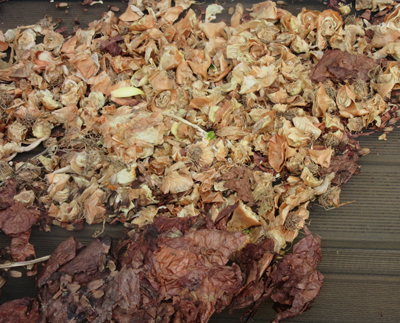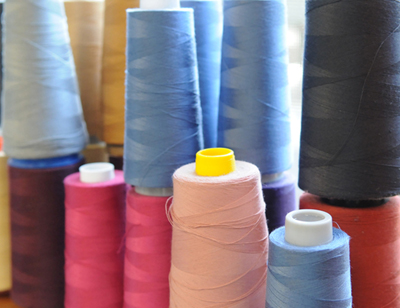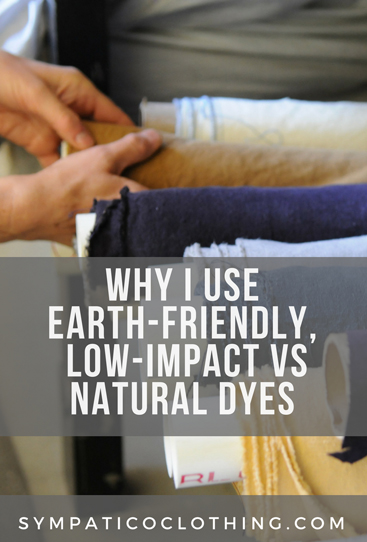Why I use Earth-friendly, low-impact vs natural dyes
When it comes to making eco friendly clothing using natural dyes is preferable to their synthetic counterparts, right? While that may make sense intuitively, as with many environmental questions, the truth is more complicated. Because we take our commitment to minimizing Sympatico’s environmental impact seriously, we’ve spent a lot of time looking at ways we can offer you a pleasing array of shades without poisoning the planet. In this article, we address the realities that involves.
What colors are best for eco friendly clothing?
Of course, we can opt to wear eco friendly clothing in its natural, undyed state. Wool, cotton and other fabrics, such as the hemp/Tencel fabric we use here at Sympatico, naturally range from off white to creamy yellow shades to browns and greys. There have been developments in the last few decades involving hybridizing cotton to offer soft pastel shades, though these are not widely available. Undyed fabrics like these offer the only truly zero-impact colors. But the reality is that modern consumers want and expect to choose from a much broader color palette.
Learn More: Conventional dyeing’s dirty secrets
Sympatico's colors are earthy and rich.
What are the Pluses and Minuses of Natural Dyes?
The fade factor: Natural dyes tend to fade faster than their synthetic counterparts, which could lead people to prematurely toss what are otherwise still wearable clothes.
Farmland for dyes, not food: Compared to synthetic dyes, naturally derived dyes must be used in much larger quantities, making them currently impractical for textiles and apparel produced in significant quantities. Where a teaspoon or two of synthetic dye will treat a pound of fabric, depending on the shade to be achieved, up to three pounds of natural dyes are needed to dye that same fabric. Switching from synthetic to natural dyes would entail committing farmland to production of the crops needed to produce those dyestuffs. Land clearing, fertilizing and insect-control could all exert powerful effects on natural ecosystems. Figuring out how to minimize those impacts is crucial in utilizing more natural dyes.
Natural substances can be toxic too. With any dyeing process, some dyes or mordants, even those derived from natural sources, may be toxic. Some plants produce toxic and allergenic substances although responsible dyers avoid using such material.

Dyestuff gathered by natural dyers.
What are the latest developments in natural dyes?
A 2017 story at Fashionista.com profiled Audrey Louise Reynolds whose Brooklyn dye works creates a wide palette from natural sources such as squid ink, flowers, shells, plankton, and soil. She counts J. Crew and Nike among her clients and also offers her dyes direct to consumers. But the production from her big-name clients were, according to Reynolds, "…something that's viable for press, something that sets them apart from producing in a factory."
Meanwhile, the leap to full-scale clothing production using natural dyes beyond experimental lines and boutique items remains a challenge. Producing dyestuffs at the scale and and at a cost demanded by most of the clothing industry is simply not a reality yet. There are promising developments though. Organizations such as outdoor apparel maker Patagonia are underwriting the considerable costs of natural-dye R&D by partnering with Reynolds. The company sees it as part of its mission statement, that in part says, "build the best product; cause no unnecessary harm."
There are other promising developments too. As detailed in a Guardian article, leading thinkers in this this field are exploring ways to make natural dyestuffs both accessible to manufacturers and viable at scale. Others are looking into potential hybrid dyes that use a mixture of synthetic and natural components.

Color can be a treat for the eyes!
So What About Fiber-Reactive Dyes?
Fiber-reactive dyes, which are produced from petrochemicals, molecularly bond with fabric, creating colorfast, long-lasting shades. They’re used on cellulosic fabrics such as cotton, linen, hemp, rayon and Tencel. They can also be used with wool and some synthetic fibers including nylon. All Sympatico clothes, apart from those in natural, are processed with fiber reactives.
Most fiber-reactive shades are classified as low-impact dyes because they meet the requirements of the Oeko-Tex Standard 100, an international textile certification program. To meet this standard, low-impact dyes cannot contain toxic substances, must have an absorption rate in which 70% or more of the dye is absorbed by the fabric and require relatively little rinse water.
Fiber-reactive dyes that are not classified as low-impact contain trace amounts of toxic metals.. As a case in point, a while back we planned to include a bright emerald in the Sympatico palette. But after hearing from our dyer that achieving the shade would require adding turquoise dye containing trace amounts of copper to the formula, we instead opted for a softer shade of green that was more environmentally friendly.

Buy Less, Dye Less
Most apparel is now made in the developing world where environmental regulations are laxly enforced or non-existent. Much of this clothing is dyed using vat and direct dyes—two classes of dyestuffs that pose substantial hazards to both people and the planet.
As detailed in a New York Times story, the impact of careless, unregulated dyeing on the environment and people’s health is an ongoing disaster that affects everyone. Although the U.S. has largely shipped its dyeing issues overseas, we’re still experiencing the consequences here. Nearly half of American workers who were exposed during the last half of the 20th century to benzidine, a compound used in vat dyeing, have developed bladder cancer.
The truth is that dyeing, like most other industrial processes, carries inevitable health and environmental consequences. The single most important thing we can do to minimize them is to reduce our consumption of stuff. The world’s current infatuation with cheaply made fast fashion is clearly unsustainable. Fires and a building collapse in Bangladesh sweatshop factories have brought both the human and environmental toll into sharp focus.
Shopping for well-made clothes that are ethically produced and designed for decades of use is part of the answer. Weaning ourselves from unconscious consumption and rethinking our attitude towards our possessions can go a long way to reversing the downsides of dyeing.
Related: Why Sympatico Chooses Low-Impact Dyes





